Southeast Asia is home to many dream destinations, but Vietnam may just be the most exciting and diverse of them all. It boasts gorgeous natural scenery, a complicated and sometimes dark history, and one of the best food scenes on the planet.
With so much to do here, working out how to experience the best of Vietnam and get the most out of your trip can be challenging on your own. But don’t worry! In this comprehensive Vietnam itinerary, we’ll tell you everything you need to know, including the best time to visit, how to get around, where to stay, and what to do in Vietnam in 14 days.
Best Time to Visit Vietnam
Think carefully about the timing of your Vietnam trip. If you go at the wrong time, you could face large crowds or, even worse, typhoons and floods.
One of the biggest challenges of planning a visit to Vietnam is that the weather varies greatly from one part of the country to the next. Vietnam has three distinct climates in the north, center, and south. As such, it can be hard to find a time that works for the entire country. For example, while the south is warm and dry from December through February, the north can be quite cold at this time. Generally speaking, the best time to visit Vietnam and have good weather across the country is in the spring, especially March and April.
As Vietnam is known for its flooding, you should avoid specific regions at certain times. In the country’s center, typhoon season runs from August to November, and flooding can be especially bad. In the north and south, the heat and humidity are felt from May through October.
Vietnam Visa and Entry Requirements
Most visitors to Vietnam must apply for a visa unless they are a citizen of one of the following 24 countries and do not intend to visit for longer than the duration listed below:
- 90 days – Chile
- 30 days – Cambodia, Indonesia, Kyrgyzstan, Laos, Malaysia, Singapore, and Thailand
- 21 days – Philippines
- 14 days – Brunei and Myanmar (Burma)
- 15 days* – Belarus, Denmark, Finland, France, Germany, Italy, Japan, South Korea, Norway, Russia, Spain, Sweden, and the U.K.
*A gap of at least 30 days between two visa-free visits is required. You must have a printout of an onward ticket.
If your country is not listed above or you intend to stay in Vietnam longer than the allotted time, you need to apply for a visa or get an approval letter from an agent in advance.
You can apply for a visa through a Vietnamese embassy or consulate. Otherwise, use one of the following methods.
- Visa on arrival (VOA): This is the most popular option for travelers arriving by air. Simply go to Vietnam-visa.com, fill out the online application, and pay the agency fee (around $20). The agency will then send you an email with the signed VOA approval letter, which you’ll need to print out and show on arrival at the VOA window. There you also pay your visa stamping fee in U.S. dollars (cash only). The stamping fee is $25 for a single-entry visa and $50 for a multiple-entry visa, which is valid for up to three months.
- E-visa: Citizens of around 80 countries, including the U.S. and U.K., can now apply for a single-entry e-visa, which is valid for 30 days and costs $25. You can apply or learn more on the official e-visa website.
Here is a quick comparison between the VOA and the e-visa:
| Visa on arrival | E-visa | |
| Applicable travelers | Travelers arriving in Vietnam via one of the 8 international airports | Citizens of 80 countries traveling to Vietnam via one of the 33 ports of entry |
| Visa type | 1-month single or multiple entry 3-month single or multiple entry 1-year multiple entry (for U.S. citizens) | 1-month single entry |
| Visa fee | Depends on your visa type; refunded if your application is denied | $25; no refund if your application is denied or your visa contains wrong information |
| Processing time | Normally 2 working days; 2-4 working hours in emergency | Normally 3 working days |
| Ports of entry | Any of the international airports, regardless of your registered airport | Registered port of entry only |
How to Get Around Vietnam
Vietnam is quite a large country. Traveling from north to south takes considerable time, so you need to think about how you’ll get around.
By Motorbike
In Vietnam, as with much of Southeast Asia, it’s rare for foreigners to drive cars. The biggest hurdle is that most rental agencies simply won’t rent one to foreigners without a local driver.
Instead, many independent travelers spend much of their two weeks in Vietnam on a motorcycle. As this is the most common mode of transport, motorbike rental companies are everywhere in Vietnam. But before you sign on the dotted line, you’ll need to make sure of a few things.
There are various factors in qualification to ride a motorcycle legally in Vietnam, including your nationality, the type of license you have, and the power of the vehicle. Also check whether your travel insurance covers motorcycle accidents.
By Public Transport
You can also get around by train or bus while visiting Vietnam. While it may not touch every stop on your itinerary, the Reunification Express train runs from Hanoi to Ho Chi Minh City. For overnight journeys, such as Hanoi to Hue, you can choose a regular seat, a hard sleeper cabin (which has beds but no padding), or a soft sleeper cabin. Reservations are necessary to secure a seat or bed. You can find some good advice from seat61 here about your booking options.
A network of coach buses also connects the country. Depending on the trip’s distance, deluxe buses feature either reclining chairs or sleeper beds and typically cost a bit less than trains. Unlike with the trains, though, you can often buy bus tickets on the day of your trip or a day before. Two trusted bus companies are The Sinh Tourist and Mai Linh Express.
Recommendation: Use Bookaway to easily compare and book train, bus, or ferry tickets in Vietnam.
By Plane
One last option for getting around in Vietnam is flying. Southeast Asia has a number of budget airlines, whose prices are often competitive with bus and train fares. You’ll miss out on the experience of seeing the countryside as you would from the train or bus, but it will definitely cut down on your travel time. We personally use and recommend Skyscanner to search for cheap flights in Vietnam.
Accommodation in Vietnam
The other major part of planning your trip is deciding where to stay in Vietnam. Staying in the right place can absolutely make your trip if it helps you get a good night’s rest and puts you among your destination’s attractions. While the right place largely depends on your travel style, here is some advice to help you discover the best places to stay in Vietnam.
First of all, if you plan to visit during the high season, you should reserve your accommodation well in advance. The sooner you book, the better your selection (and possibly prices) will be.
Vietnam caters to backpackers, luxury travelers, and everyone in between, so it surely has various accommodations that will suit you. We recommend using certain websites to find the right place for you. Booking.com is the best site to find places to stay in general, whether you’re looking for a hotel, guesthouse, or apartment.
Backpackers and budget travelers should also check Hostelworld – you’ll be dazzled by how cheap the dorms and rooms in hostels are. You can also find recommendations in our guides on the best hostels in Ho Chi Minh City, Hanoi, and Hoi An.
Of course, Airbnb is the place to look if you value local or unique experiences. Whether you want to have a place all to yourself or stay in a host’s spare room, Airbnb can offer a great time.
In case you just want to find accommodations quickly, we’ve provided our recommendations for each stop on this Vietnam itinerary below.
The Perfect 2-Week Vietnam Itinerary
Our Vietnam travel itinerary will show you how to tackle this amazing country, ensuring that you see the best places to visit in Vietnam. The itinerary begins in the country’s north with Hanoi and works its way south to Ho Chi Minh City, but the reverse works just as well. You’ll see not only major cities, but also awe-inspiring landscapes, beaches, waterfalls, and temples. By the end, you’ll be ready to plan your second trip!
However, before we get to our Vietnam itinerary and the best places to visit in Vietnam, we just wanted to remind you to purchase travel insurance. You never know what will happen and, trust us, you do not want to get stuck with thousands of dollars in medical bills. As a wise man once said, “If you can’t afford travel insurance, you can’t afford to travel.” So don’t leave home without it.
SafetyWing offers travel insurance for only about $10 a week, making it a no-brainer to get. You can get a quick, non-binding quote below:
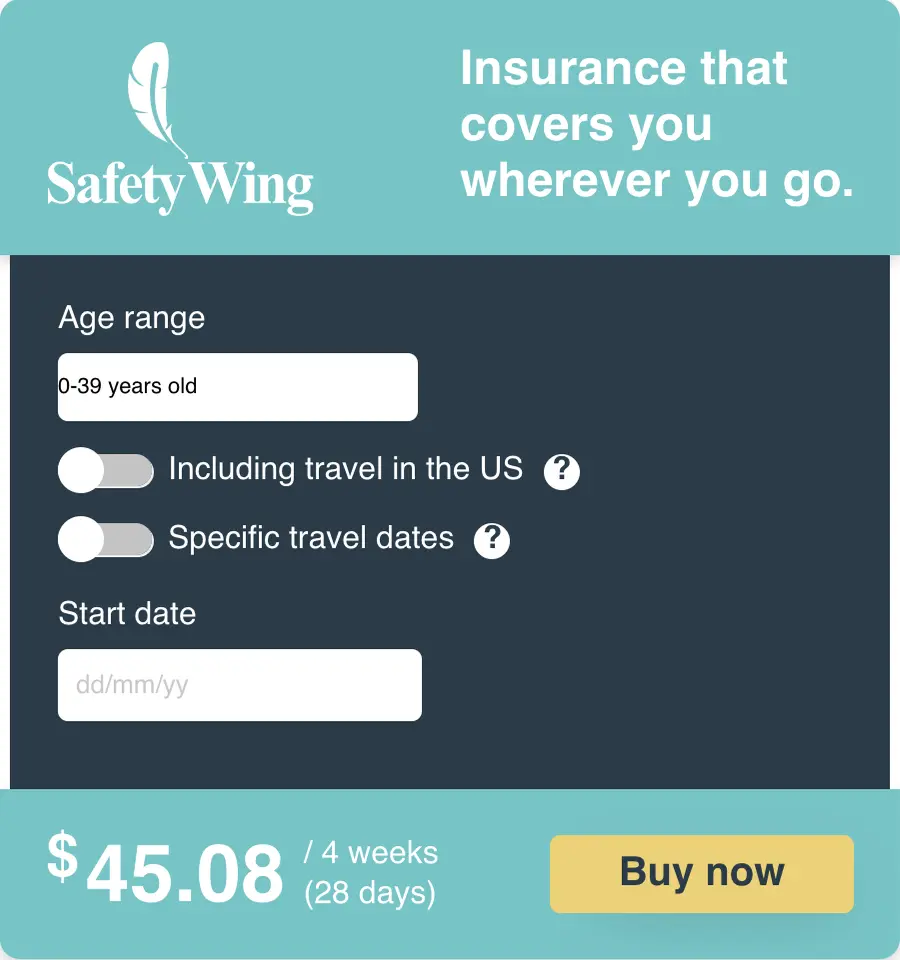
SafetyWing is, of course, not the only option available. Two other popular alternatives are World Nomads and Heymondo.
All right, let’s get back to your guide for a fun two weeks in Vietnam. We’ll show you all the best things to do in Vietnam, one destination at a time.
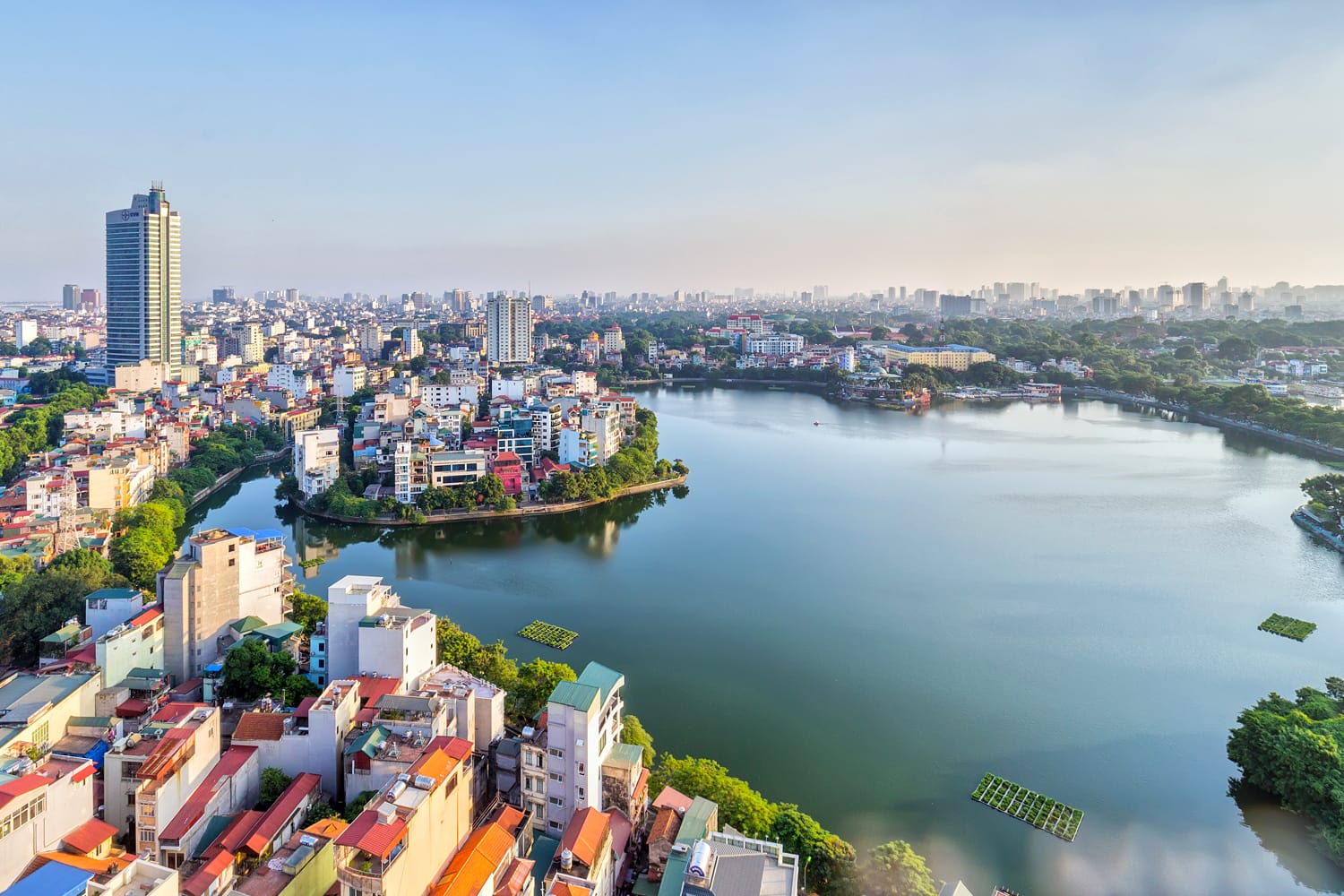
Day 1: Hanoi
Your visit starts in the north with Hanoi, the capital of Vietnam. This wonderful city is full of history, character, and remnants of its French colonial past.
Begin with the Hanoi Old Quarter, simply wandering the streets and taking it all in. With all the traffic, signs, and buildings, this part of the city can be overwhelming at first, but you’ll quickly learn to love the chaos. The same goes for the French Quarter to the southeast, although the two neighborhoods couldn’t look more different.
Between those two quarters is Hoàn Kiếm Lake, which feels like the center of Hanoi both geographically and socially. Locals meet, exercise, and do tai chi here, and there are also some interesting sights. Crossing the bright red Húc Bridge (a popular spot for photo shoots), you’ll reach the Temple of the Jade Mountain, where you can see a preserved giant turtle among the ancient artifacts inside.
Just a short walk away is the memorial site of Hỏa Lò Prison, once ironically nicknamed “the Hanoi Hilton.” First a colonial prison for political prisoners, this building became famous for housing U.S. prisoners of war and now has displays detailing its history. On the far side of the train tracks from here is the Temple of Literature, a historic Confucian temple dedicated to students and scholars.
In the evening, take a guided street food tour or pull up a chair at a restaurant in the Old Quarter. For just a few dollars, you can enjoy local dishes such as bun cha or pho and wash them down with bia hoi, a local draught beer.
Best places to stay in Hanoi:
Further reading: 3 Days in Hanoi: The Perfect Hanoi Itinerary
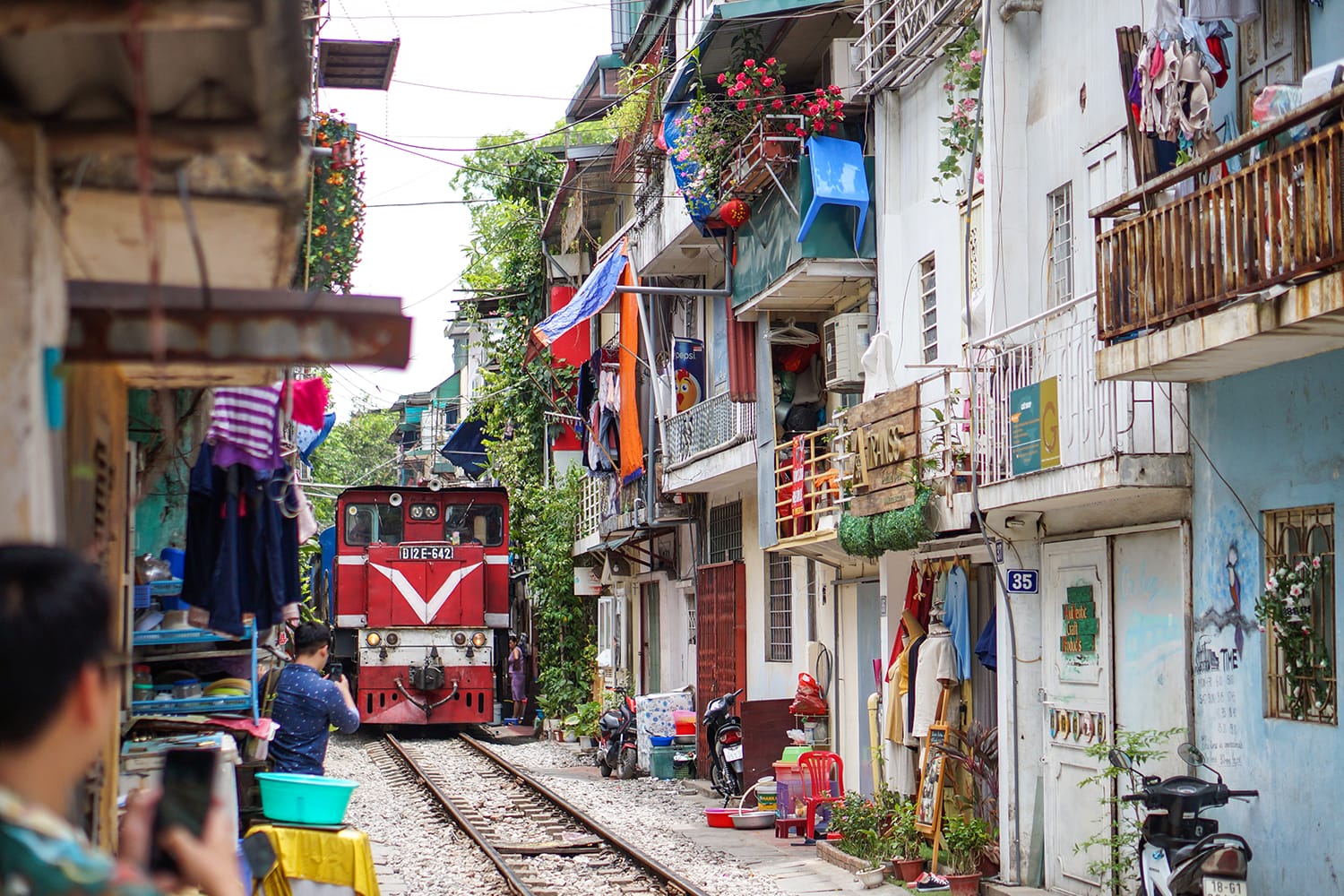
Day 2: Hanoi
On your second day in Hanoi, you still have plenty of major sights to find. Set out first for the President Ho Chi Minh Mausoleum. Inside lies the glass-enclosed body of the country’s revered Communist revolutionary leader, surrounded by an honor guard. Next, duck around the corner to the Ho Chi Minh Museum, which details the life and work of Ho Chi Minh and the history of the Vietnam revolution.
Venturing out into the backstreets, find Huu Tiep Lake, where the remains of a U.S. bomber still lie. Heading back toward the mausoleum, take a moment to admire the One Pillar Pagoda – a serene Buddhist temple – before continuing on to stand outside the immense Presidential Palace of Vietnam. Continuing north will take you to Trấn Quốc Pagoda, an ancient Buddhist temple encompassing several islands.
Back in the middle of the city, you’ll see a giant Vietnamese flag marking the fascinating Vietnam Military History Museum. Right next door sits the Imperial Citadel of Thăng Long, a large palace complex reached through imposing gates. Head back toward the city center to see the famous Hanoi Train Street, where trains barrel through a narrow channel between houses.
Finish your day by finding a good vantage point above Dong Kinh Nghia Thuc Square to watch the blur of traffic surrounding this iconic roundabout and nightlife area.
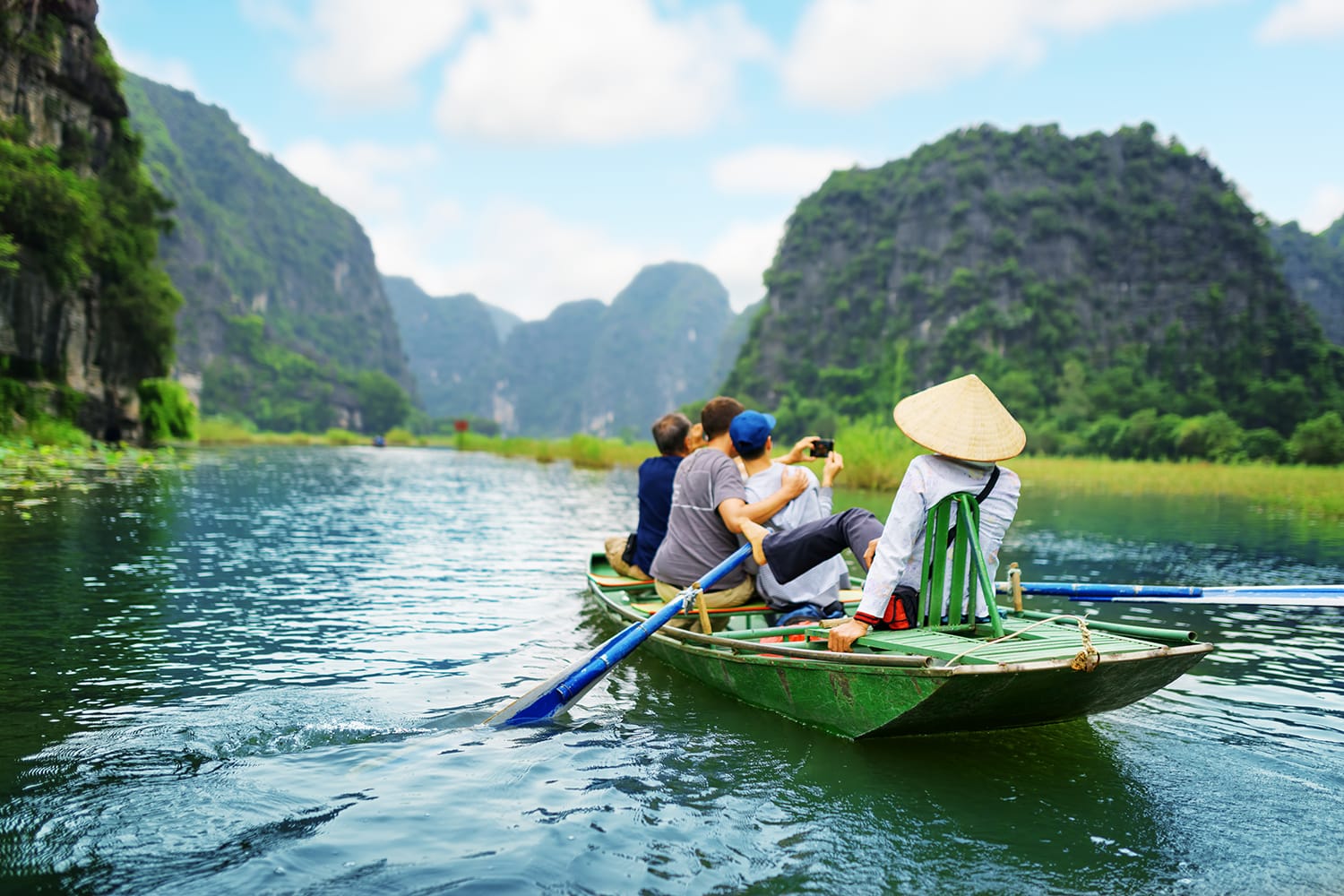
Day 3: Ninh Binh
There’s no better way to spend your last day in Hanoi than with a trip south to the province of Ninh Binh, one of the most popular day trips from Hanoi. This rural area is full of natural beauty, thanks to the rivers and karst mountains springing out of its rice terraces.
The main highlight of Ninh Binh is the chance to drift lazily through the scenic landscape in a small boat. Whether it’s at Tràng An or Tam Cốc, you’ll pass between high mountains, alongside rice terraces, and even through a few caves. Afterward, you can appreciate this incredible scenery by heading up Hang Mua Peak to enjoy panoramic views from its temple and cave.
Beyond nature, you can see plenty of religious and historical sites dotting the landscape of Ninh Binh. Not far from the Tam Coc river cruise site sits the ancient Bich Dong Pagoda, while the temple complex around the Bai Dinh Pagoda is off on its own to the north.
A major historic site worth your time is the ancient city of Hoa Lu among the steep karst mountains. This was the capital of Vietnam during the 10th and 11th centuries. The city now sits in ruins, but you can visit some fortifications and temples.
Recommendation: If you don’t want to venture out on your own, consider booking a guided tour to Ninh Binh. For example, this small group tour takes you to all the best spots, including Tam Cốc, Hoa Lu, and Mua Cave.
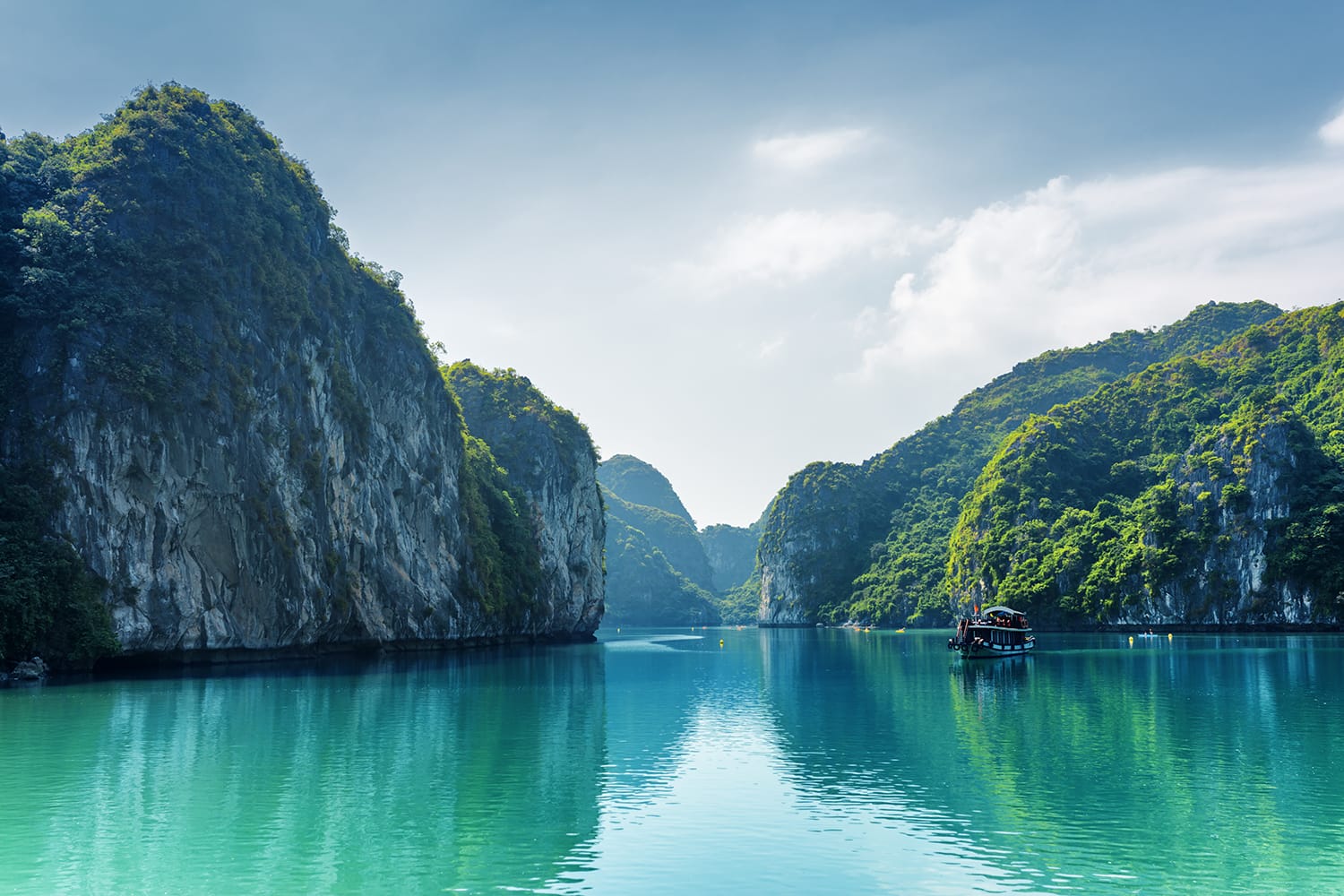
Day 4 – 5: Ha Long Bay
Ha Long Bay is one of the highlights of a trip to Vietnam for many visitors. This vast bay on the northern coast is home to thousands of limestone islands jutting into the sky, few of which are settled or inhabited. Thanks to this fascinating and beautiful natural phenomenon, Ha Long Bay is a UNESCO World Heritage Site.
Visiting Ha Long Bay will involve a tour of some sort, most often an overnight cruise – one of the best tours in Vietnam. Setting out from the city of Ha Long, you’ll spend two days cruising around the bay and enjoying its endless beauty. There are boats of various sizes and styles to fit all budgets.
These cruises usually include several activities besides simply admiring the majestic scenery, such as kayaking, exploring the floating villages and markets, cooking classes, and squid fishing. They also make various stops, including a climb through Sung Sot Cave and a sunset hike to a lookout point on Monkey Island.
On the second day, you’ll take a leisurely cruise back to port. You can lounge on the deck and simply enjoy floating past the islands of Ha Long Bay. This is a good chance to relax before you get back on the road.
These two tours come highly recommended, offering a choice between an overnight cruise and a day trip:
- Ha Long day tour: Islands, caves, kayak with Dragonfly Cruise
- Ha Long Bay 2-day tour with Deluxe Cruises
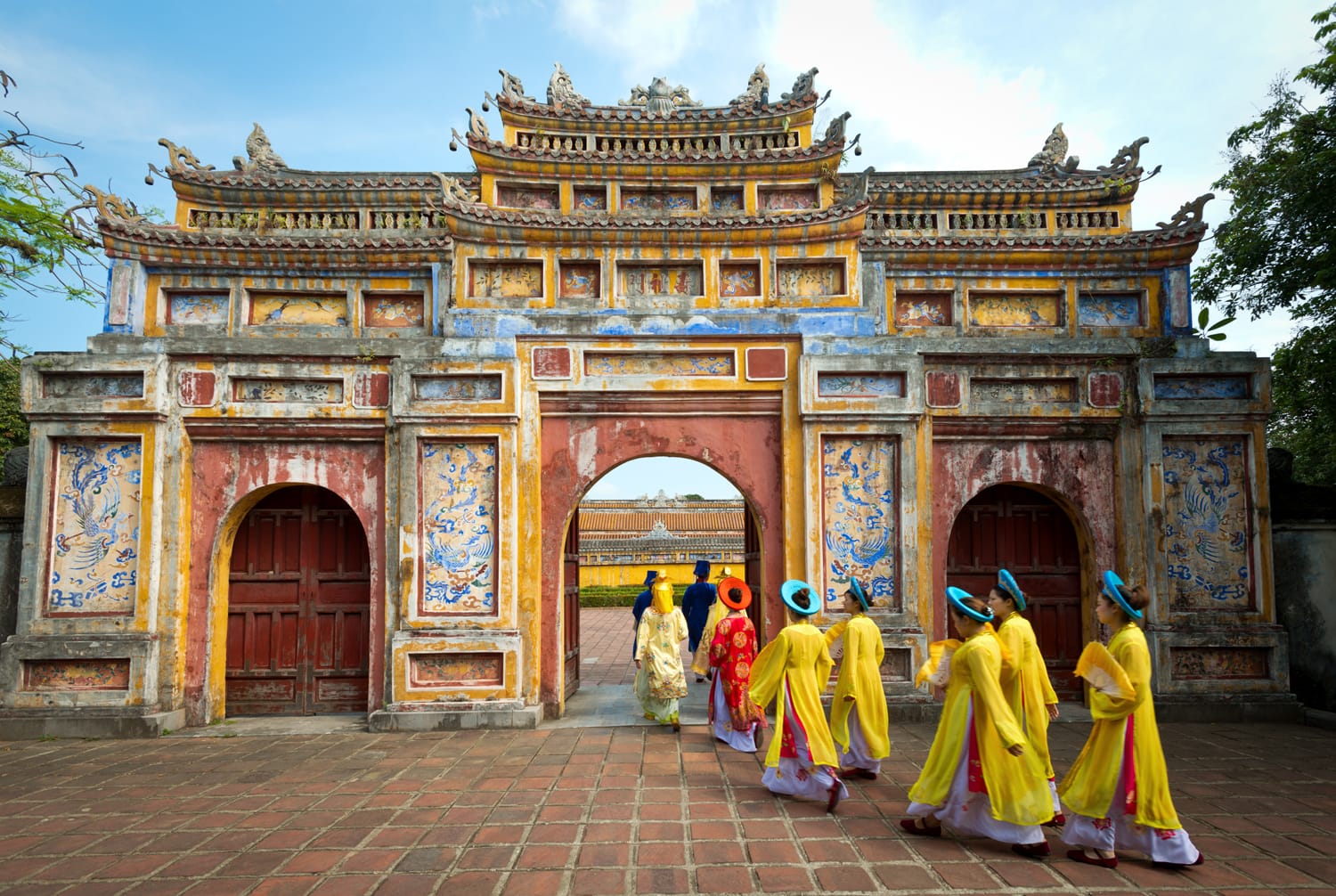
Day 6: Hue
Next on our itinerary is a short stop in the historic city of Hue. A single day here will allow you to see the essential sights, but you could easily spend several days sightseeing.
There’s no better place to start your visit than the Imperial City. This vast citadel was the seat of power when Hue was the capital of the Empire of Vietnam. Once you pass through the layers of immense city gates and moats, you’ll be facing several palaces and temples, including Thế Miếu. It’s well worth wandering the outer streets to find beautiful gates, quiet courtyards, and open sections of the city walls. Don’t miss the free Hue Museum of Royal Antiquities, which covers the city’s imperial heritage.
A walk along the northern bank of the Perfume River will take you to the Thiên Mụ Temple. This tranquil Buddhist temple is best known for its seven-story pagoda, with stairs leading to it right from the river. Other temples just outside Hue include the Từ Hiếu Pagoda and Huyen Tran Princess Temple.
You can also visit several imperial tombs upriver from Hue. Set close together just a few miles from the city, the mausoleums of emperors Khải Định, Minh Mạng, and Tự Đức all have their own design and intriguing elements to explore.
Best places to stay in Hue:
Further reading: 1 Day in Hue: The Perfect Hue Itinerary
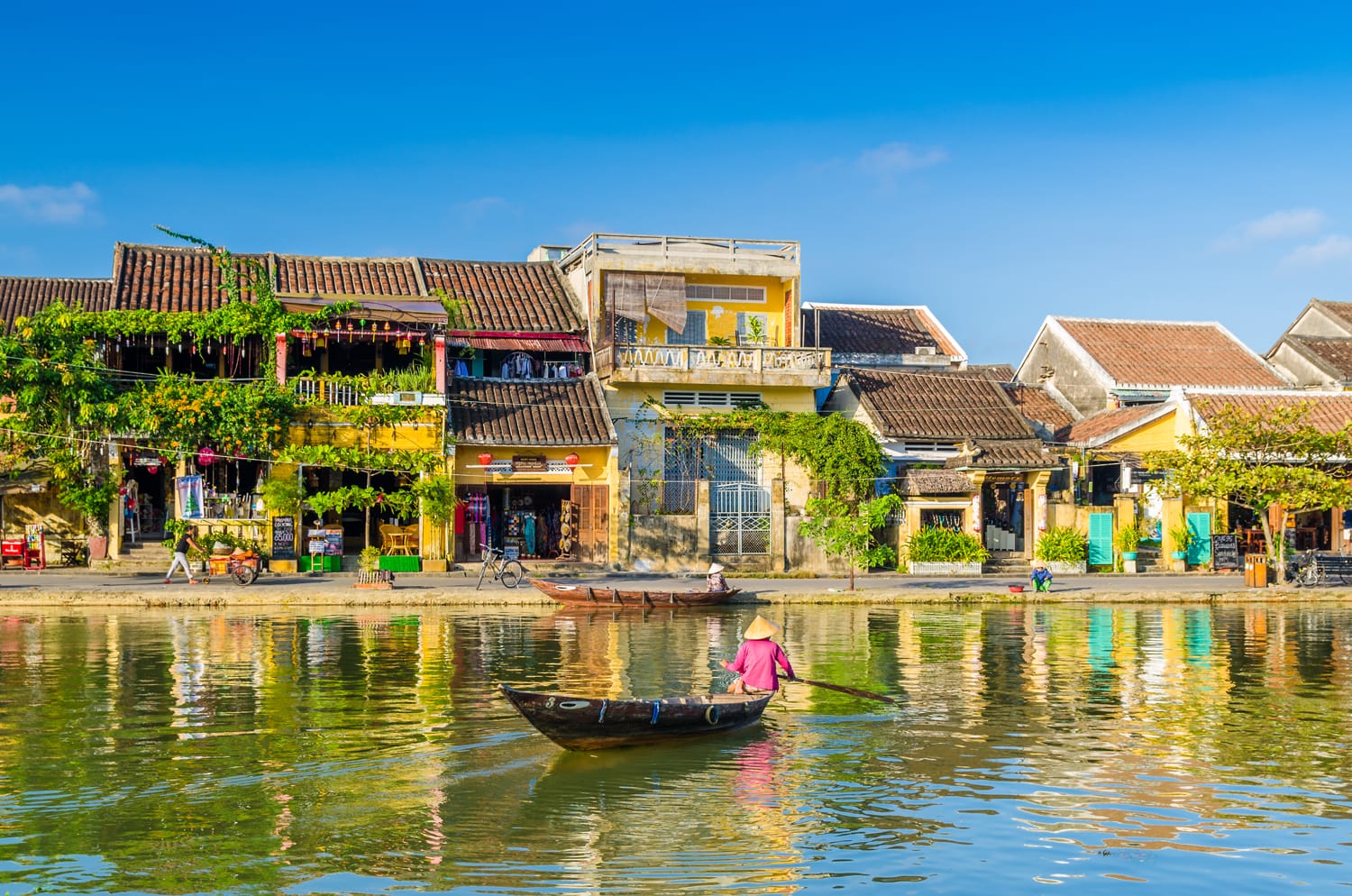
Day 7: Hoi An
Heading further south along Vietnam’s coast, you’ll arrive in the wildly popular city of Hoi An. Smaller than the other stops on this itinerary, Hoi An makes up in sights and atmosphere for what it lacks in size.
Much of what you’ll see on your first day here is within the UNESCO World Heritage Site of Hoi An Ancient Town. A trading port dating back centuries, the Ancient Town is exceptionally well preserved and best recognized for its faded yellow merchant houses. You could easily spend your time here just wandering from one picturesque street to the next and never grow bored.
The Ancient Town’s chief landmark is the photogenic Japanese Covered Bridge. Dating back to the 17th century, the bridge was built by the now-gone Japanese community and is an icon of Hoi An. The Ancient Town also features the Old House of Phung Hung, the Phuc Kien Assembly Hall, and other buildings that show you more of the city’s incredible heritage. Head next to the Hoi An Museum of History & Culture to see how little it has actually changed over the years.
Once the sun goes down, make your way to the Hoi An Night Market. Whether you want to buy souvenirs or are craving some street food, this is the place to go. The river area is especially pretty at night, making it a great time for a drink at one of the waterfront venues.
Best places to stay in Hoi An:
Further reading: 3 Days in Hoi An: The Perfect Hoi An Itinerary
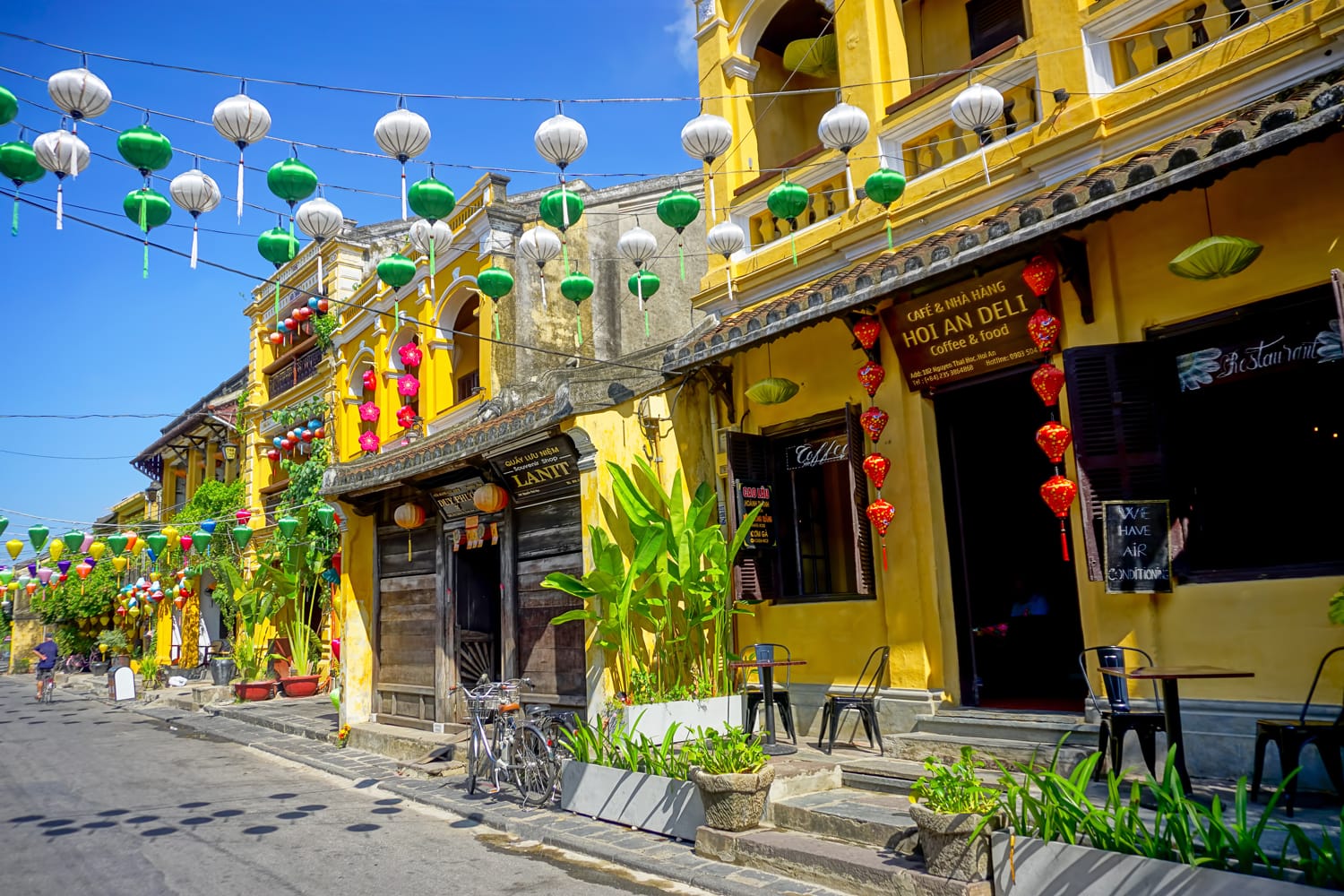
Day 8: Hoi An
Having seen the main sights in the city center, you can now experience all the other great things to do in Hoi An. Leaving the Ancient Town for a calmer setting, we cross to the island village of Cẩm Nam. You’ll find yourself surrounded by fruit trees and be treated to some nice views back to the Ancient Town.
Next, it’s time for some activities that make the most of the locals’ skills. This could mean visiting a tailor for some affordable custom clothes or taking a cooking class and trying a few new dishes. If you’d like to see the small farming community that your food has been coming from, take a trip up to the Tra Que Vegetable Village.
For the rest of your day, take it easy on one of Hanoi’s public beaches. There are many beautiful options along the coast, but An Bang Beach and Hidden Beach are considered the city’s best.
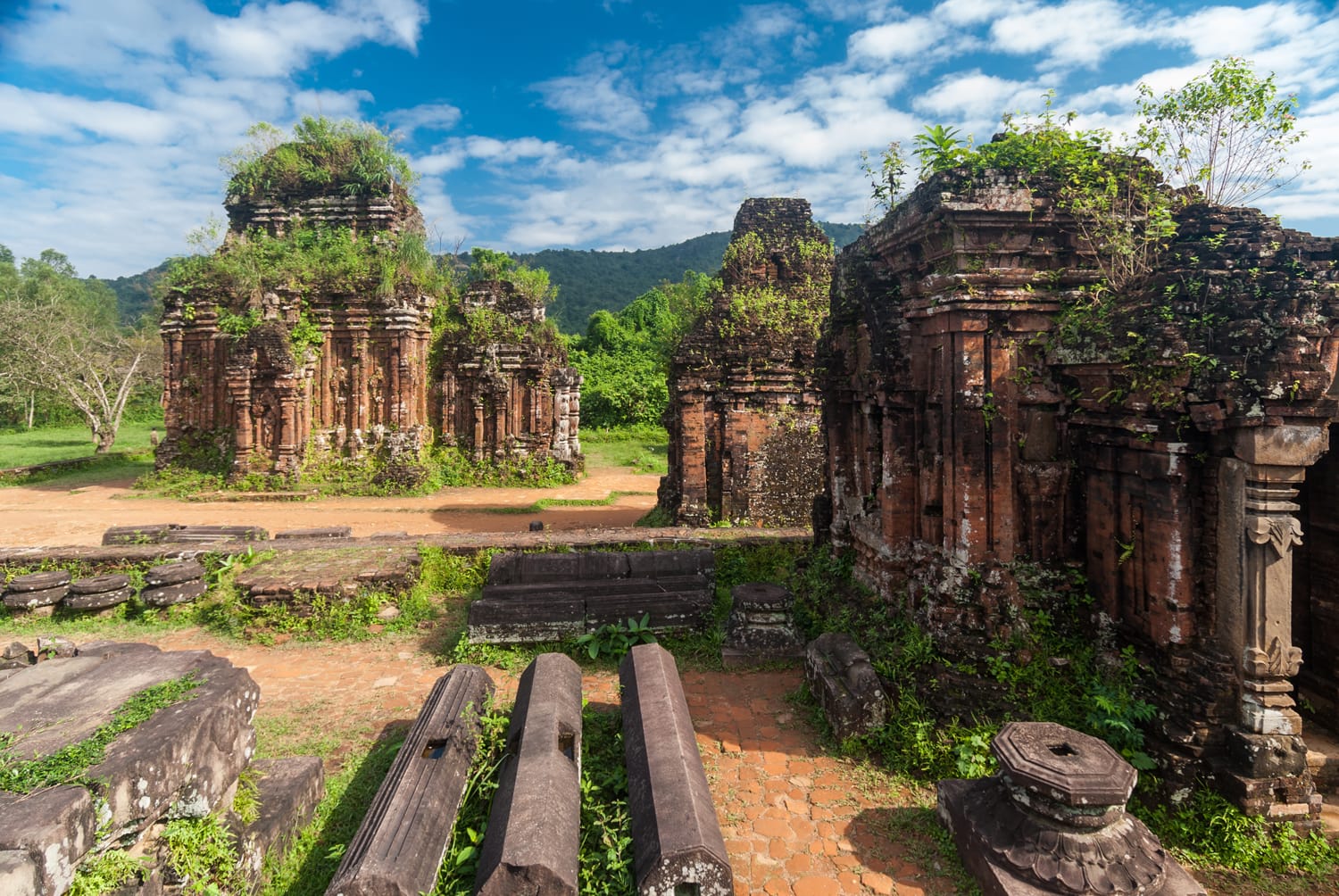
Day 9: Hoi An
Being conveniently located on Vietnam’s central coast, Hoi An is an ideal place to strike out from to explore some of the surrounding areas. You have plenty of options for day trips from Hoi An, but we’ve listed some recommendations below.
- Da Nang: Though it’s just north of Hoi An, Da Nang couldn’t be more different. The city is more modern, tending to lure visitors seeking shopping opportunities and time at the beach. Of Da Nang’s many beaches, My Khe Beach and Non Nuoc Beach are the most popular. There are still some classic landmarks here, though, such as the fire-shooting Dragon Bridge, the swinging Hàn River Bridge, and the pink Da Nang Cathedral. The newest tourist spot near Da Nang is the Golden Bridge in the Ba Na Hills, which rests on a pair of giant stone hands and is an Instagram favorite.
- Marble Mountains: Halfway between Hoi An and Da Nang, five limestone and marble hills spring from the flat landscape by the coast. They’re all a striking sight, but Mount Thuy is the one you can climb. As you make your way up the stairs, you can visit shrines, pagodas, and several caves. Once you reach the panoramic viewpoint, you’ll be able to see the other Marble Mountains and up the coast.
- Mỹ Sơn: There are several UNESCO World Heritage Sites in this part of Vietnam, including the ancient ruins of Mỹ Sơn in an overgrown valley. A relic of the Champa kingdom, the site comprises over 70 Hindu temples and tombs of Cham royalty, dating from the fourth to 14th century A.D. While some of the structures are in a rough state with nature slowly overtaking them, others still have clear carvings and iconography. You can book a guided tour to Mỹ Sơn here.
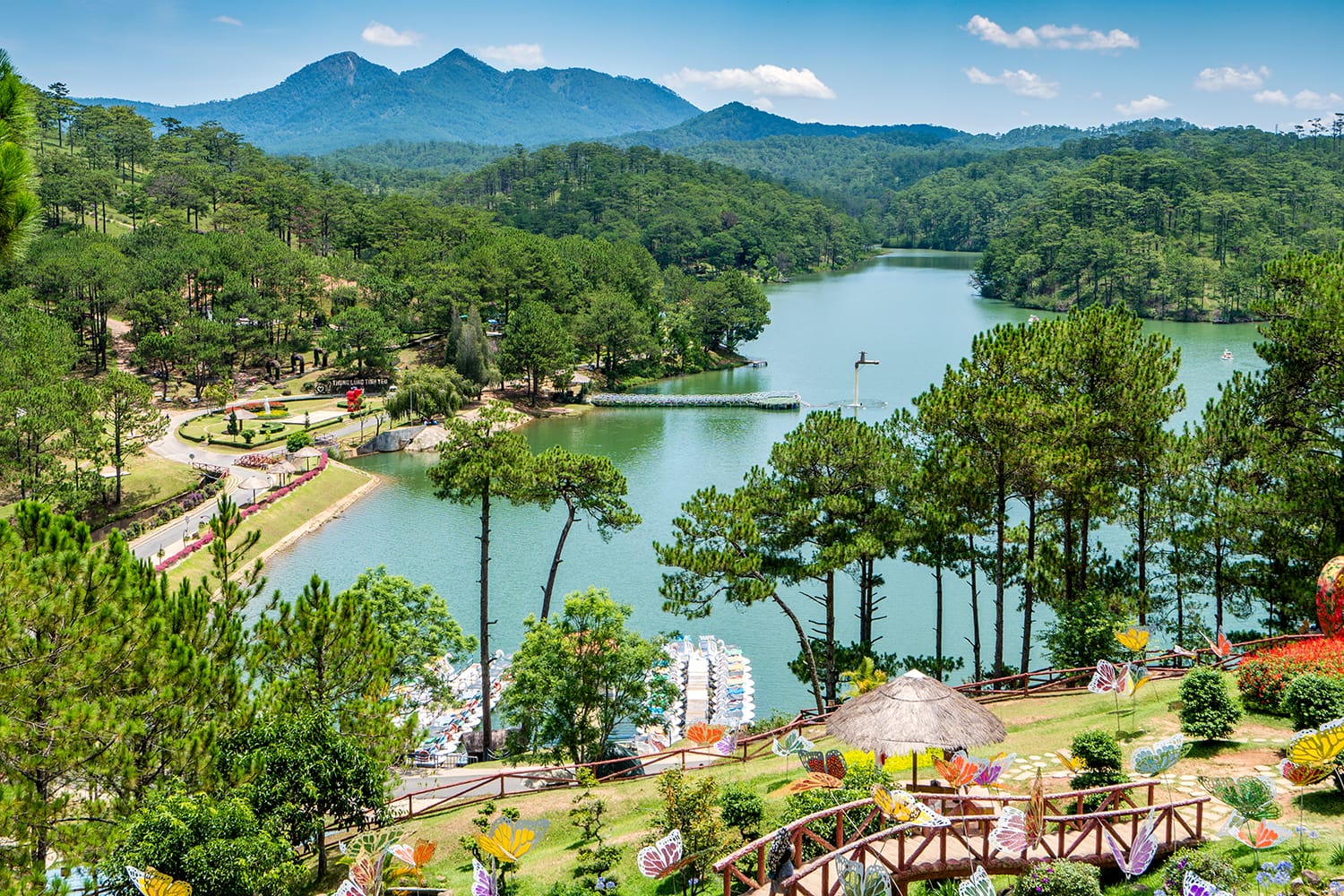
Day 10: Da Lat
Much further south, in the Central Highlands, lies your next stop, Da Lat. Not as popular as the other destinations on this list, Da Lat reveals yet another side to Vietnam with its hillsides covered in forests and waterfalls.
Start your visit with the unique sight of the Crazy House. Like something out of Alice in Wonderland, this house has an eccentric design with rooftop walkways and warped tree trunks. A little farther up the hill is the more conventional Bao Dai Summer Palace (officially known as the Third Mansion of Bao Dai), which was a summer residence for Vietnam’s last emperor in the 20th century.
Down in the city center, take a stroll along the picturesque Xuan Huong Lake. As you walk around, you might forget that you’re in Vietnam and not an Alpine region of France. Stop at Lam Vien Square to check out all the modern structures in this flower-themed space.
Take a quick trip to the northern end of the city to visit the giant golden Buddha at the Thiền Viện Vạn Hạnh, a temple complex visible from across the city. Returning to the city center, visit the Da Lat Market for some shopping and wait for the night market to open.
Reward yourself for a busy day of sightseeing with a visit to the 100 Roofs Cafe, hidden in back alleys not far from the market. Actually a bar, this venue has a similar trippy, maze-like nature to the Crazy House, with random staircases, dead ends, and strange overall decor. Once you find your way to the roof, you can enjoy a drink as you look out over Da Lat.
Best places to stay in Da Lat:
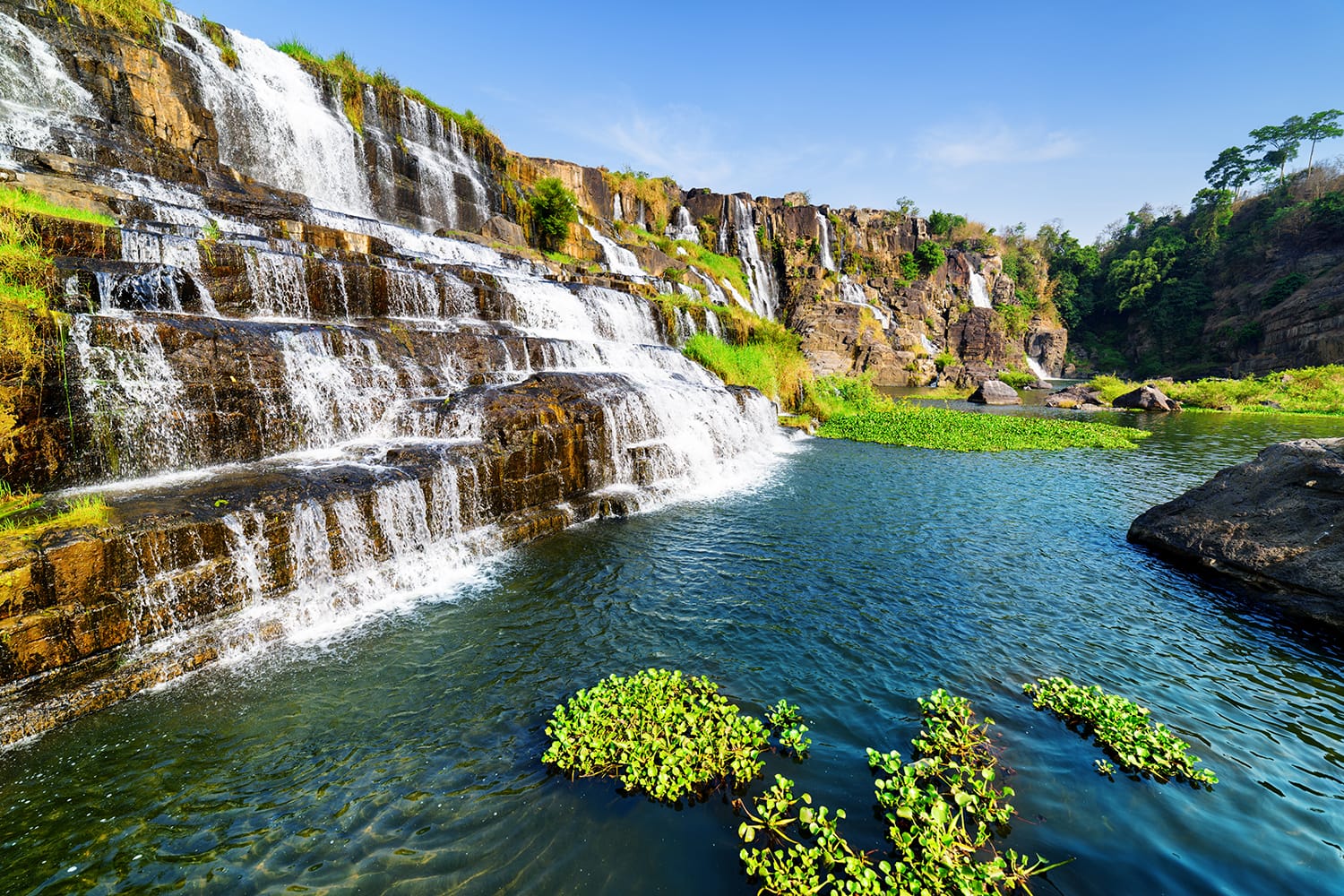
Day 11: Da Lat
While we’ve seen many of the attractions in the center of Da Lat, we have a lot to see in the outskirts of the city and the countryside. First up is the Valley of Love, a park that treads the line between kitsch and romantic. Still, the view of the terrace gardens over the lake is worth the stop.
We then trade one lake for another with a visit to the Trúc Lâm Temple on the opposite side of the city. Accessible by a cable car ride over hills and forest, this active Buddhist monastery is appropriately Zen. From the temples, wander down to Tuyền Lâm Lake for a pleasant stroll through nature.
Now, it’s finally time for the amazing waterfalls surrounding Da Lat. You’ll find both the Datanla Waterfall and Prenn Waterfall close to the monastery. A small roller coaster runs from the top to the bottom of the Datanla and back, making it easy to get back up from the lowest waterfalls. A bit farther from Da Lat, you’ll find the largest of the three waterfalls, Elephant Falls. As with the Prenn, you can actually walk behind Elephant Falls, but with no roller coaster at this waterfall, you’ll have to take a slippery path to the bottom first.
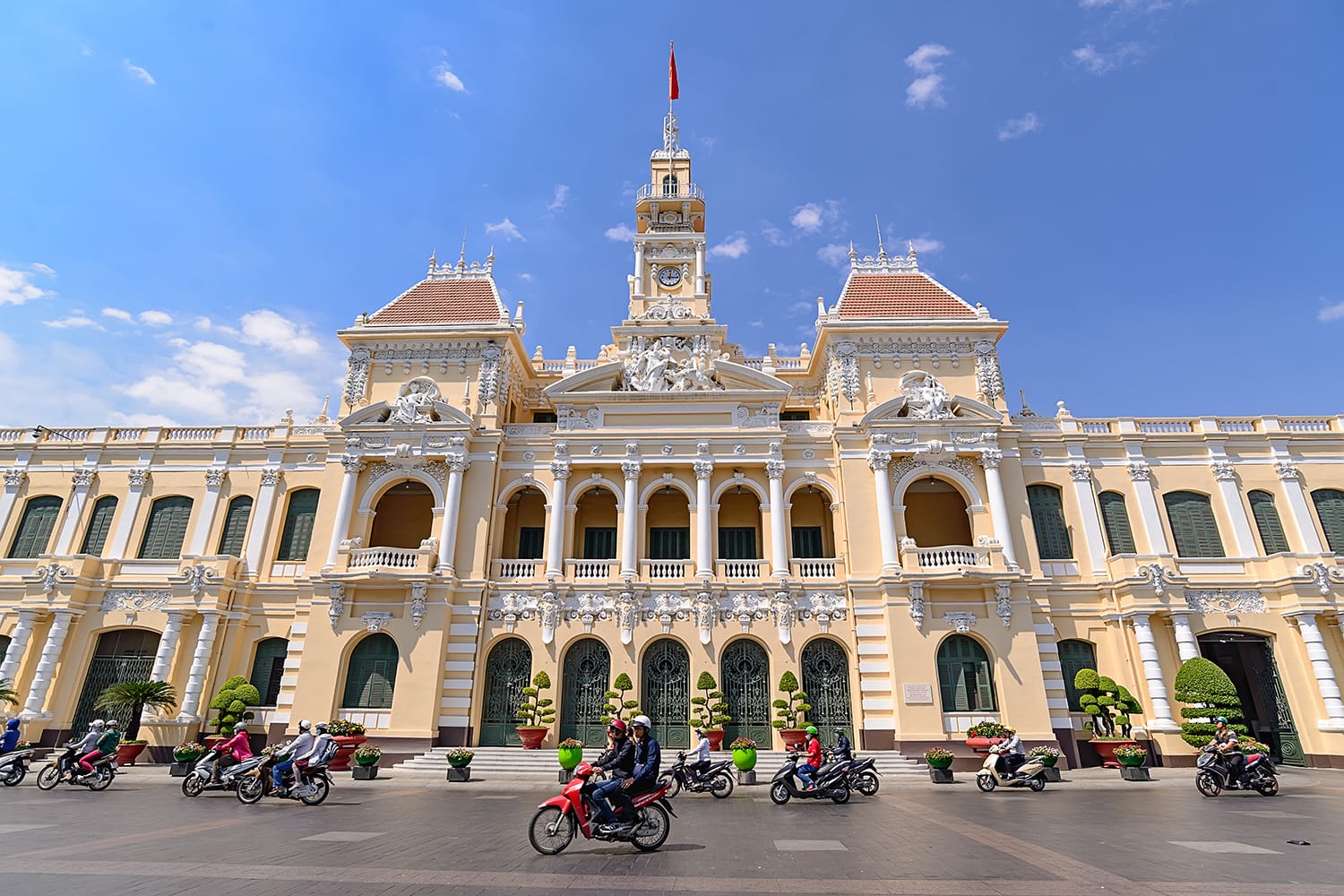
Day 12: Ho Chi Minh City
Your last stop on this epic trip through Vietnam is Ho Chi Minh City. Still often referred to by its old name, Saigon, this massive city is known for the various colonial landmarks sprinkled throughout the modern metropolis.
Begin your sightseeing with Ho Chi Minh City Hall, a majestic building with a French colonial design. Just a short walk away, you’ll find two other major landmarks left over from the French, the elegant Notre Dame Cathedral Basilica of Saigon and the beautiful Saigon Central Post Office. As strange as it sounds, this is one post office you’ll want to spend some time in.
Next, visit the War Remnants Museum to learn more about the Anti-French Resistance War and the Vietnam War. While many exhibits are incredibly moving in the way they show the realities of war, the exhibit on Agent Orange can be a difficult reality to swallow.
To see Ho Chi Minh City from a different perspective, make your way up the Bitexco Financial Tower. From the Saigon Skydeck on the 49th floor, you can see just how sprawling the city is. Next, before its doors close at 6 p.m., wander through the Bến Thành Market to find all sorts of produce and souvenirs. Stick around after closing to grab dinner at the night market.
Best places to stay in Ho Chi Minh City:
Further reading: 3 Days in Ho Chi Minh City: The Perfect Saigon Itinerary
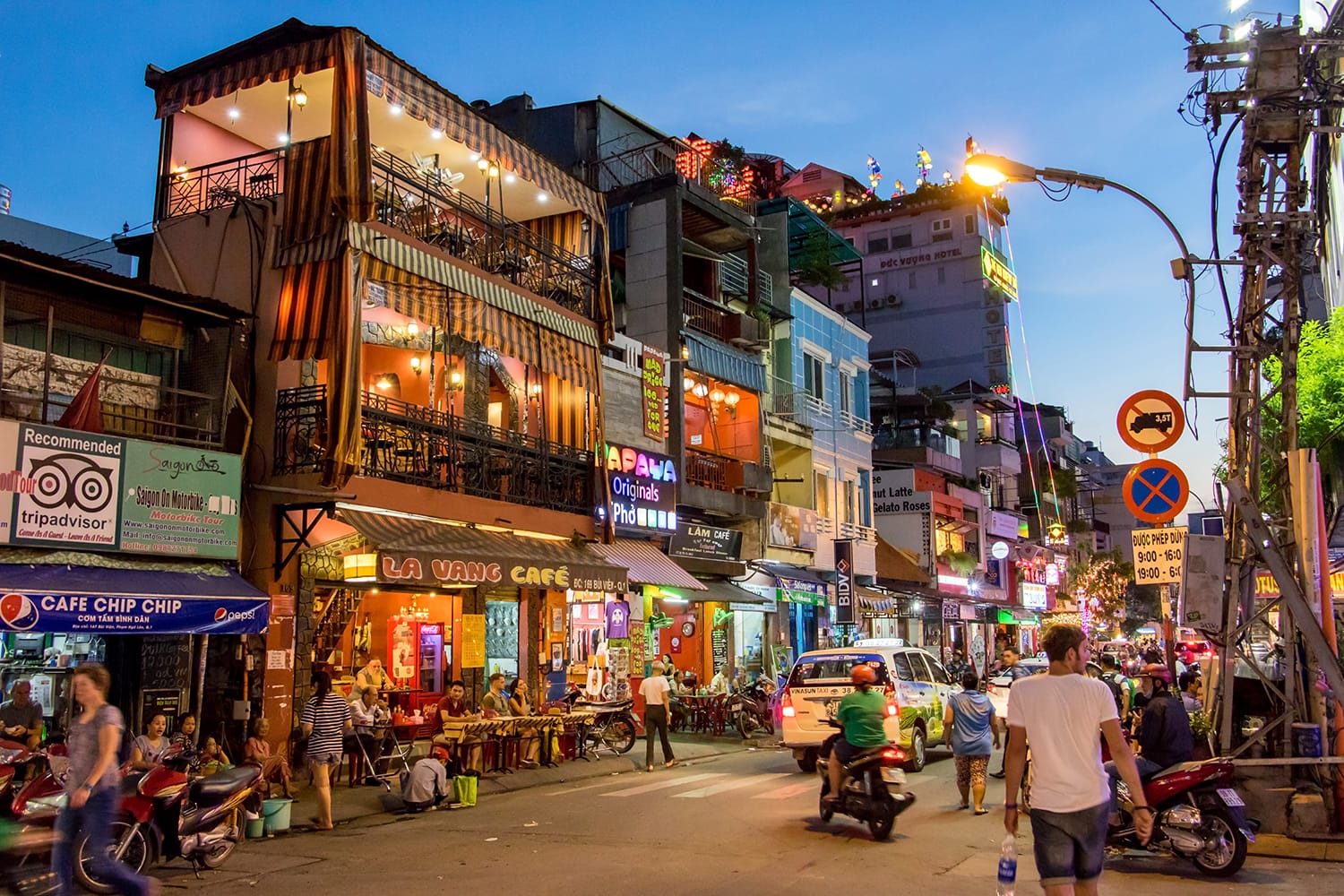
Day 13: Ho Chi Minh City
You still have plenty of things to do around the city on your second day, starting with the Independence Palace. Built in the ’60s during the Vietnam War, this was the home of the president of the Republic of Vietnam. It’s also where the Vietnam War officially ended when a tank rolled through its gates in 1975. You can tour the building to see the offices, presidential rooms, and war rooms, which all seem trapped in time.
On a walk through the city center, you can see more of Saigon’s diverse religious communities. Make your way to the surprisingly pink Tân Định Church and on to the Jade Emperor Pagoda. This Taoist temple is only 100 years old, but the evocative statues and figures make it quite a sight. Much farther from the city center, you’ll find Giác Lâm Temple, the oldest temple in town.
You have several options for the rest of your time here. If you’re interested in history, you can visit either the Ho Chí Minh City Museum of History or the Museum of Vietnamese History to learn about the region’s history beyond the last 60 years. To sample more of Saigon’s food scene, consider a street food walking tour, such as this private motorbike tour, or a cooking class to learn how to make some yourself.
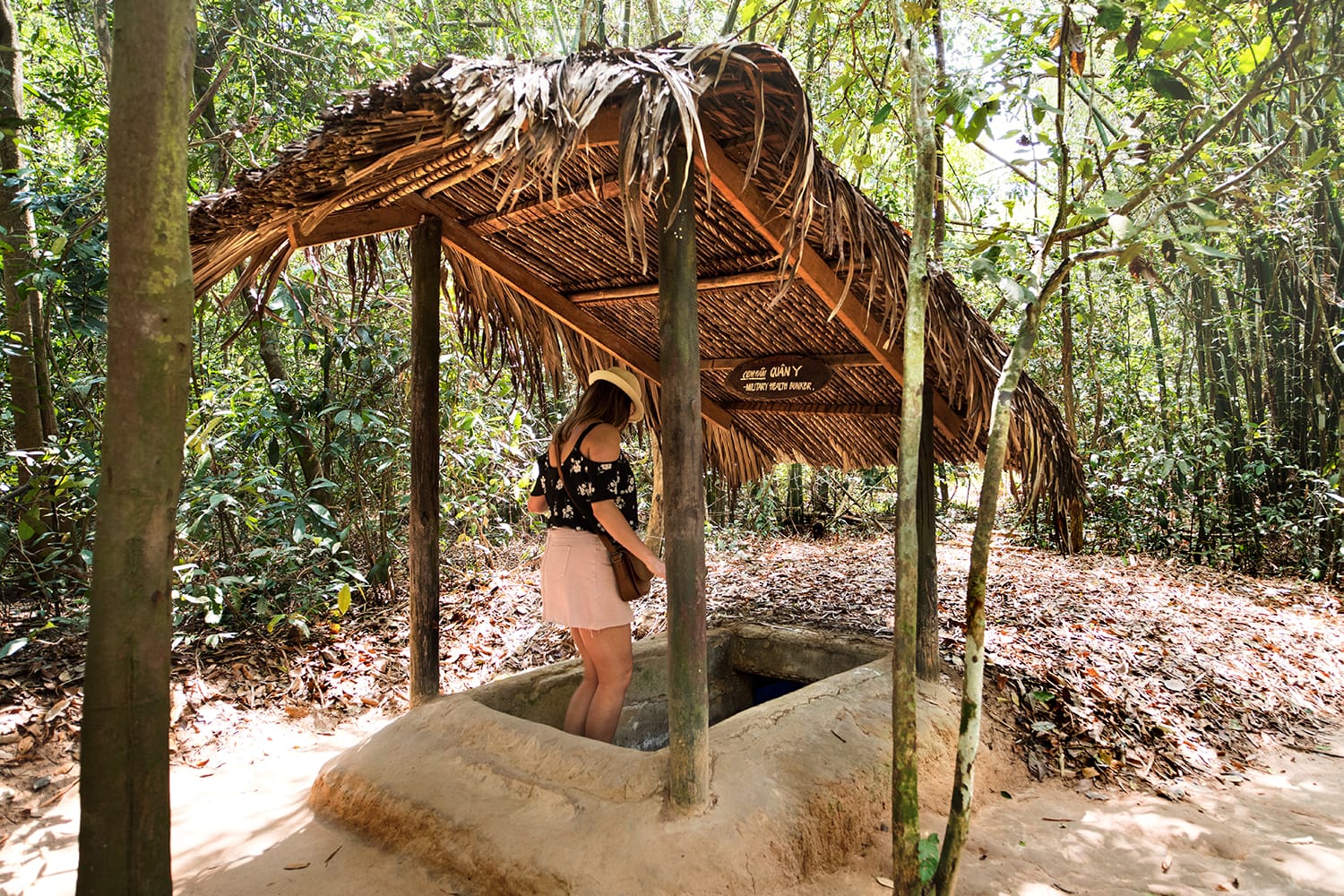
Day 14: Ho Chi Minh City
Ho Chi Minh City is the gateway to Vietnam’s southern destinations, so you’ll want to use your last day here to explore more of what the country has to offer. Many day trips are possible from the city, showcasing the country’s nature, history, and cultural treasures. We’ve listed some day trips from Ho Chi Minh City that you’ll want to consider below.
- Tunnels of Củ Chi: There’s no shortage of places to visit related to the Vietnam War, but one of the most popular is the Tunnels of Củ Chi. Built by the Viet Cong in the fight against U.S. forces, these narrow tunnels allowed the soldiers to ambush troops, but they also served as living spaces and supply routes. Exploring the site of the tunnels, you’ll see how well hidden their entrances were and some of the traps for foreign forces. You can even climb into a stretch of the cramped tunnels and walk through it. You can book your tour to the Tunnels of Củ Chi here.
- Black Virgin Mountain: For some quality time in nature, head for Black Virgin Mountain. This extinct volcano rising out of farmland is ideal for hiking and also holds some Vietnam War history, having been the site of many battles. You can either hike right from the park entrance or take a cable car part of the way up. Besides enjoying the natural scenery and the views from the top, you can visit several pagodas here.
- Cao Dai Temple: While you’ve encountered many religious sites in Vietnam so far, it’s unlikely you’ve even heard of the religion of Caodaism, which originated in southern Vietnam in the 20th century. You can learn about this relatively new faith at the Cao Dai Temple outside the city of Tây Ninh. You can explore the temple complex (formally known as the Tây Ninh Holy See) and sit in on a service, watching worshippers pray inside the vibrantly colorful main temple. With the incorporated elements of various other religions, the experience may feel both familiar and completely new.
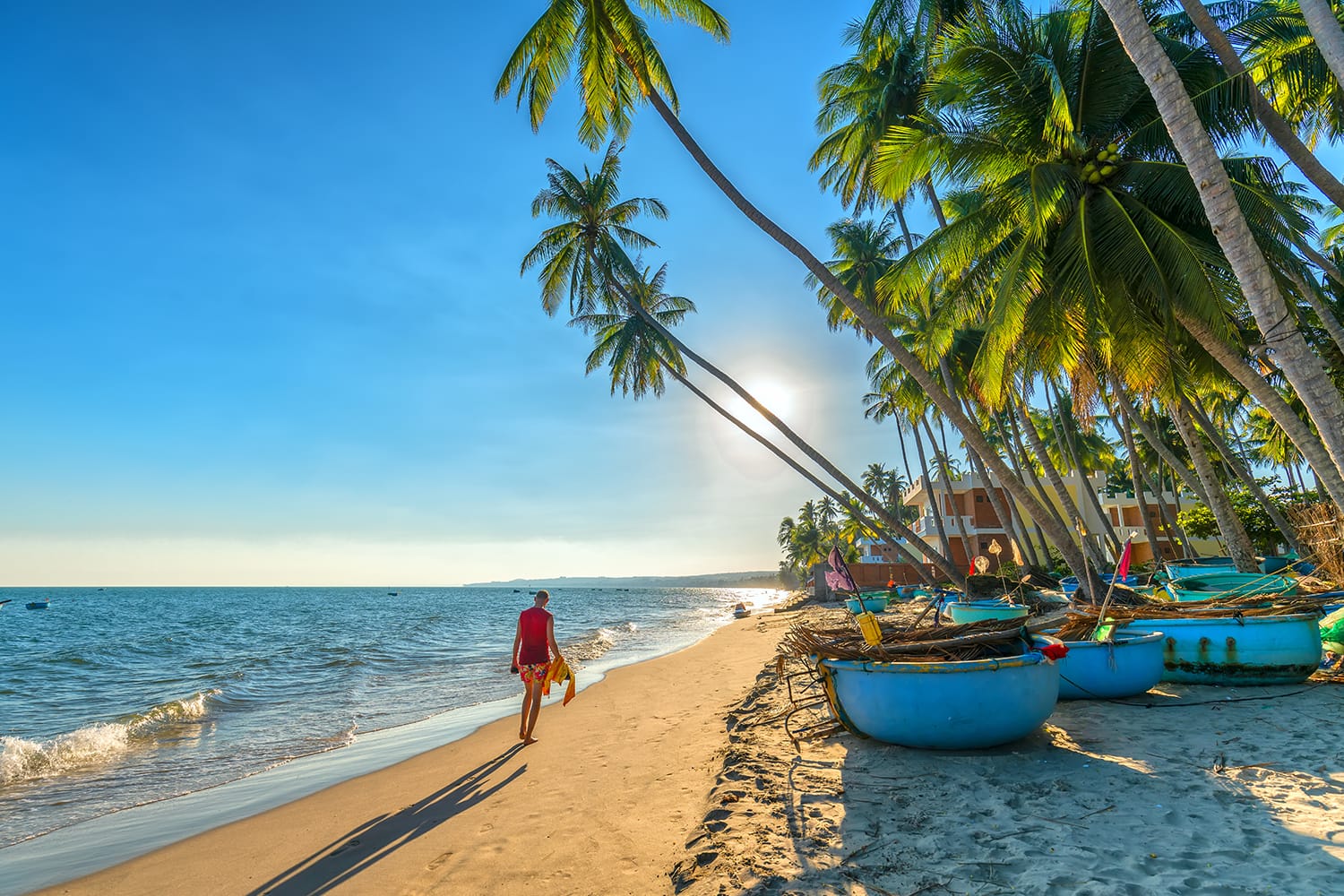
Day 15 and Beyond
Our 14-day itinerary gives you a solid foundation for your first visit to Vietnam. We’ve covered many of the country’s popular destinations, but there’s plenty more to see if you have time. To give you an idea of what else you can add to your itinerary or destinations that you can look forward to for next time, we’ve listed some other great places to visit in Vietnam below.
- Mekong Delta: The Mekong River is a major feature of many southeast Asian landscapes, but Vietnam is where it finally flows out into the sea. While that may sound ordinary, the Mekong Delta is nothing but incredible, made up of a sprawling network of rivers through coastal swamps. Local residents spend most of their lives surrounded by water. Take a river cruise through the swampy maze, visit floating markets, and spend the night among rural rice paddies. You can book a guided tour of the Mekong Delta from Ho Chi Minh City here.
- Sa Pa: Up in the mountainous north by the Chinese border lies the remote town of Sa Pa. Visitors come to the area’s Hoàng Liên National Park to trek along valleys and through rice terraces, stopping to interact with the local ethnic minorities of the region. While you can visit some villages and waterfalls directly from Sa Pa, tourists typically spend several days hiking across the region and maybe even climbing Fansipan, Vietnam’s highest mountain. You can book a guided trekking tour to Sa Pa from Hanoi here.
- Mũi Né: The town of Mũi Né is another one of Vietnam’s beach getaways, with several sandy beaches on either side of town and resorts all along them. Kiteboarding and windsurfing are also popular here, thanks to the onshore winds. There are some other natural attractions too, including the beautiful Red Sand Dunes, the White Sand Dunes farther out, and the picturesque Fairy Stream trickling through an eroded canyon.
As you can see, you can experience so many great places by traveling through Vietnam in 14 days. You might even have a new favorite country as you look back on all the fun you had!
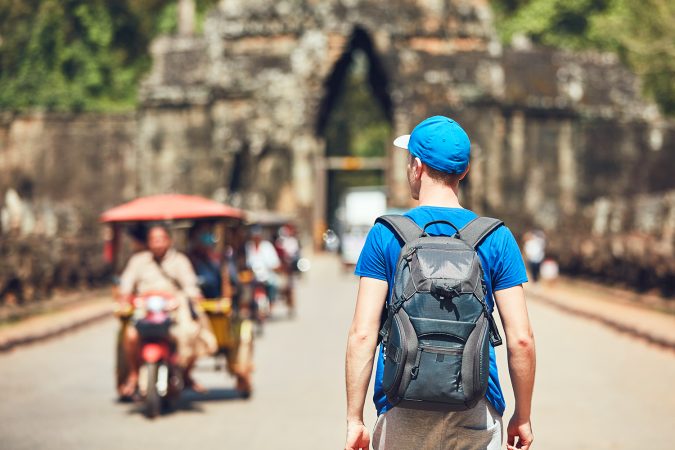
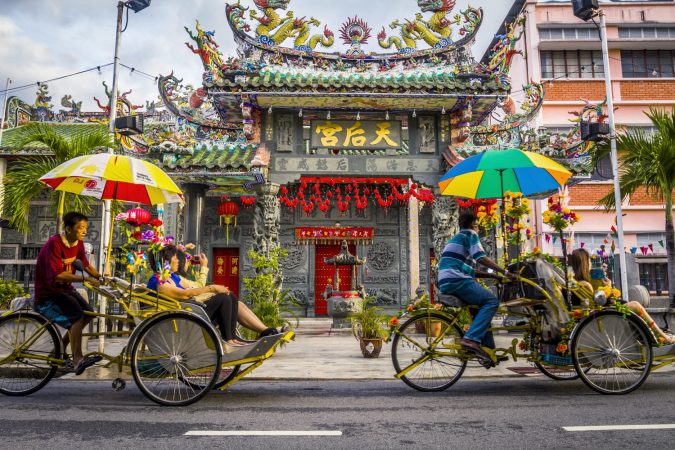
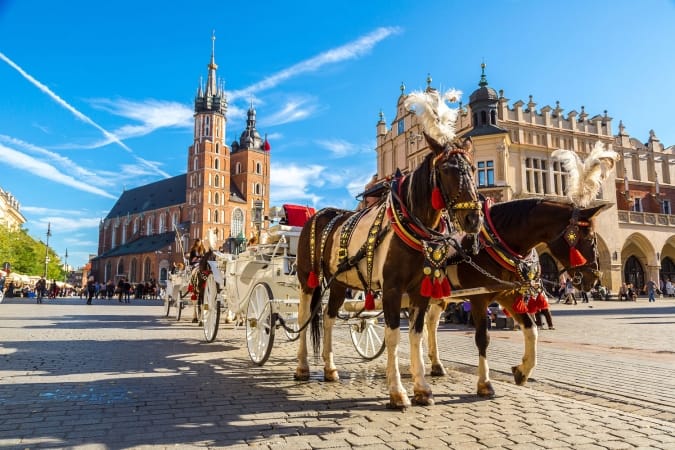
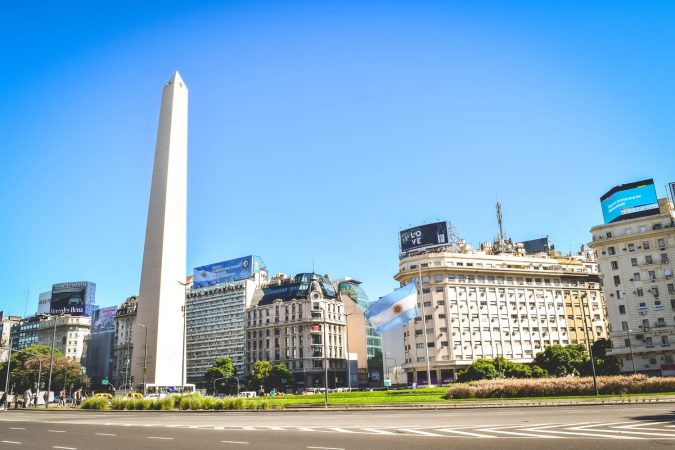
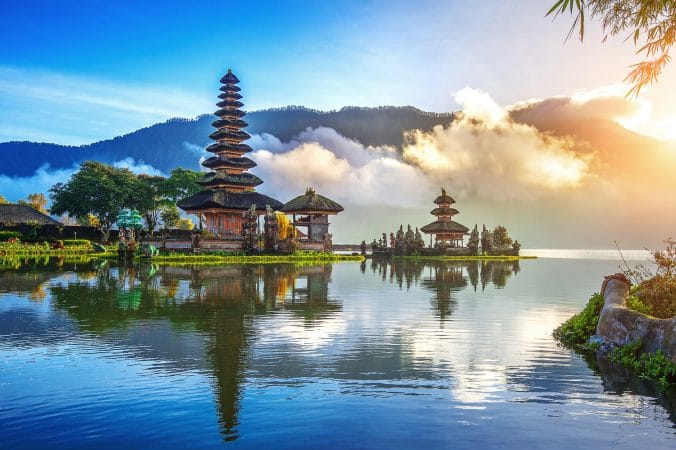
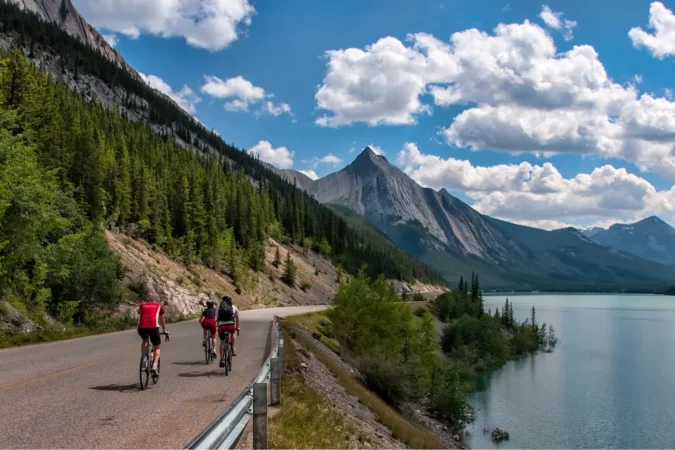

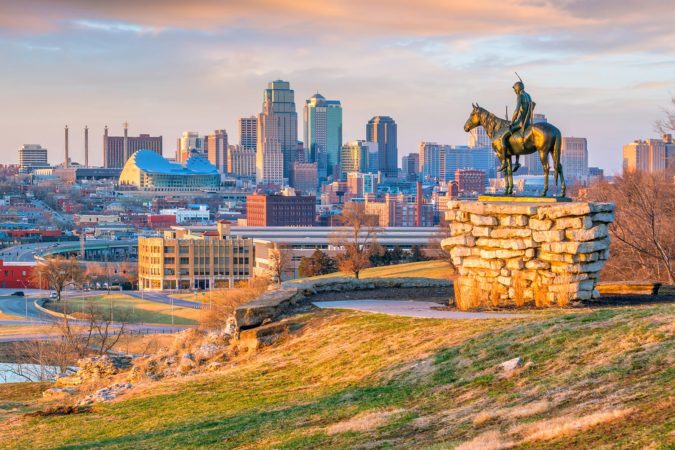
Comments